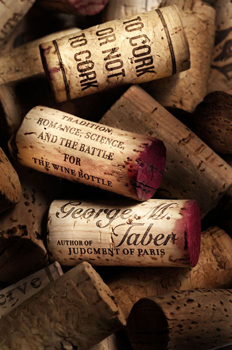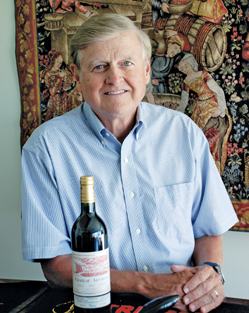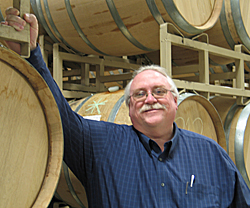

George Taber did extensive research into the best closures for wines for his new book To Cork or Not To Cork?
To cork or not to cork?
George Taber wrote the book on it
Are prejudice and extreme positions for cork or screwcap prevailing? Well...yes and no.
by
Eleanor & Ray Heald
October 26, 2007
 ike the alcohol percentage in wine debate, the issue of appropriate closures has also amped up. In its ongoing effort to ensure balanced editorial on important topics, APPELLATION AMERICA continues to post well-studied thoughts by opinion makers.
ike the alcohol percentage in wine debate, the issue of appropriate closures has also amped up. In its ongoing effort to ensure balanced editorial on important topics, APPELLATION AMERICA continues to post well-studied thoughts by opinion makers.
George M. Taber, author of Judgment of Paris (2005) has just released his second, well-researched book, To Cork or Not to Cork (Scribner, NY, October 2007), in which he reports that an expert wine taster can note cork taint when only one part per trillion (ppt) is present in a wine. An average consumer will usually detect it at about five ppt. As a point of comparison, "one ppt is equivalent to one second in 320 centuries," he details. "But it's enough to ruin a bottle of wine."
No one knows precisely when the first cork was inserted as the closure for a wine bottle. A good estimate is that for four centuries, natural cork has been the wine bottle closure of choice. Yet, in the 1980s, 2,4,6-trichloroanisole (TCA), which was identified in that decade by a Swiss researcher, began to cause cork-taint problems that nearly forced some wineries out of business.
In the August 20, 2007 APPELLATION AMERICA posting "To Screw Cap Wine Bottles or Not", Tablas Creek Vineyard General Manager Jason Haas said, "Industry estimates range from three percent to as high as 10 percent of corks are tainted.

Author George M. Taber.
According to Taber, cork's critics consider that failure rate to be "both outrageous and unacceptable. They repeatedly argue that if three percent to five percent of Toyota cars or IBM computers failed, those companies would be out of business."
How did the cork taint problem get so bad and why has it been allowed to go on so long? There’s two answers for that: the historical one and the scientific one.
Historically, Taber lays cork taint escalation directly at the feet of the Portuguese cork supply industry. He begins his historical details in the late 1960s with the research of Hans Tanner at the Wädenswil Institute in Switzerland, then time warps to his personal visit to the Portuguese wine industry in 1975, as a continuation of his work on the taint problem. Back then, Tanner noticed workers boiling batches of corks in caldrons of chlorinated water to bleach them and suspected that this caused the TCA problem.
According to Taber, after publishing his study, Tanner received a letter from the head of Gütlig Corks stating he should not have done this because "it would give cork a bad image." Taber questioned Tanner 25 years later asking why he believed that the Portuguese cork industry ignored his work. The answer: "They felt that if they ignored the problem, it would go away. They were also afraid that if they examined their corks, too many of them would be rejected."
Taber comments that "Given the [Portuguese cork] industry's inability to control the quality of its product and [since it had a] market monopoly for closures, it's not surprising that the cork industry as a whole chose to do nothing and to blame any problems on its consumers or just ignore them." Taber concludes that this attitude caused two decades of delay in action to alleviate the problems identified in 1981.
Nowhere in any wine trade journal have we read such a biting condemnation of the Portuguese cork industry. We asked Taber if he believed that this may be because trade journals depend on cork supply advertising, and they too, ignored the issue. Taber says that he can't speak for industry publications, yet adds, " There is no question that the Portuguese cork industry is a very big advertiser in many wine publications, and the division of what journalists call “church and state” is not always as clear as it should be in wine publications. Editorial decisions are clearly sometimes made on the basis of advertising. That having been said, some publications or journalists have taken strong stands on the issue. One that comes immediately to mind is James Laube of Wine Spectator, who is strongly anti-cork. His publication, though, has not been totally on one side of the issue."
The Long Search For Solutions
Chapters that Taber dedicates to TCA problem solutions read like a David Baldacci page-turning novel. In addition to a scathing attack on the Portuguese cork trade, he tackles the French cover-up of its corked wines, including Champagnes, in the 1980s.Meanwhile, in the same time frame, with California winemakers literally shouting for a closure other than natural cork, or the plastic alternatives which were then available, Supreme Corq was born with Murphy-Goode in Sonoma County's Alexander Valley, St Francis in Sonoma, Bonny Doon in Santa Cruz and Chateau Ste. Michelle in Washington State offering guidance in product development.
We spoke with St. Francis Winery winemaker Tom Mackey who said that in 1995, using the beige/tan cork color, he switched to Supreme Corq for all bottlings. Before that, from 1992 to 1995, he used Cellucork.
"After 15 years of using synthetic closures and testing others," Mackey says, "we believe that the perfect closure has yet to be invented. That said, we have been and continue to use Supreme Corq for St. Francis Sonoma County

Natural corks still control more than 80 percent of the market for wine bottle closures.
With better mouse traps always in order, competition created Neocork, Nomacork and others. Yet today, natural corks still control more than 80 percent of the market for wine bottle closures. However, Portuguese cork producers can no longer ignore alternatives. And, truth be told, winemakers can't continue to ignore problems such as lack of tight fit, when there are now alternatives with which to avoid wine oxidation. One element, however, is clear. "Supreme Corq," writes Taber, "created greater public awareness of cork's problems by offering the wine world and its customers a credible solution."
Taber explains conditions other than natural corks that can result in tainted wines. Along with research that proved TCA is the cause of cork taint, it was

St. Francis Winery’s Tom Mackey










 READER FEEDBACK: To post your comments on this story,
READER FEEDBACK: To post your comments on this story,





